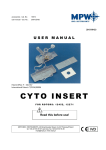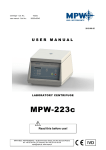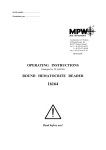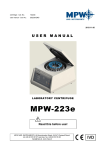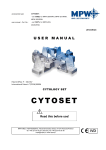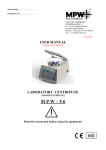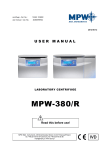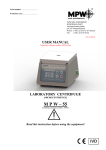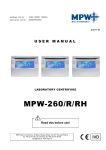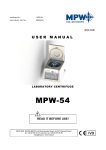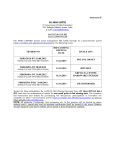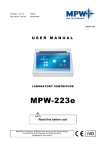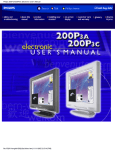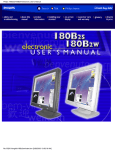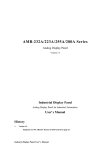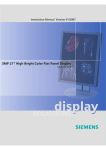Download - MPW MED. INSTRUMENTS Spółdzielnia Pracy
Transcript
serial nu centrifuge - Cat. No.: user manual - Cat. No.: 10223a 20223a/ENG 2012-01-20 USER MANUAL LABORATORY CENTRIFUGE MPW-223a Read this before use! MPW MED. INSTRUMENTS, 46 Boremlowska Street, 04-347 Warsaw/Poland tel.+48 22 610 81 07 (service), fax +48 22 610 55 36 [email protected], www.mpw.pl Contents 1. Application 2. Technical data 2.1. Accessories 2.1.1. Basic accessories 2.1.2. Optional accessories 2.2. 3. 4. Installation 3.1. Unpacking of the centrifuge 3.2. Location 3.3. Connection to mains 3.4. Fuses Description of the centrifuge 4.1. 5. 6. Exploitation materials General description Safe working conditions 5.1. Operating personnel 5.2. Guarantee period and operation life 5.3. Safekeeping period 5.4. Hints on centrifuging 5.5. Hazards and precautions Operation of the centrifuge 6.1. Mounting of the rotor and accessories 6.2. Construction and safety measures 6.3. Drive 6.4. Data setting and read-out 6.5. Controls 6.6. Safety devices 6.6.1. Cover lock 6.6.2. Rest state check 2 7. Description of the centrifuge operating elements 7.1. Control panel 7.2. Switching the centrifuge on 7.2.1. Selection of the program 7.2.2. Start of the program 7.2.3. Emergency stop 7.2.4. End of the centrifuging 7.2.5. Programming 7.3. Mathematical relations 7.3.1. RCF – relative centripetal force 8. Cleaning, disinfection, maintenance 8.1. Cleaning of the centrifuge 8.2. Cleaning of the accessories 8.3. Sterilization and disinfection of the rotating chamber and accessories Emergency conditions – service 9. 9.1. 10. Troubleshooting Work safety 10.1. Work safety inspection procedures 10.2. Inspection procedures carried out by the operator 11. Conditions of repairs 12. Manufacturer’s data 13. Information about Distributor Annexes: Statement of conformity Declaration of decontamination (repair) Declaration of decontamination (return) 3 1. Application The MPW-223a centrifuge is a table top laboratory centrifuge intended for in vitro diagnostic (IVD). Its construction ensures easy operation and safe work during analyses in laboratories. It is intended for column tests. This centrifuge is not biotight. 2. Technical data Manufacturer: “MPW MED. INSTRUMENTS” SPÓŁDZIELNIA PRACY 46 Boremlowska Street Warsaw, Poland Type: MPW-223 a Mains: L1+N+PE V/Hz ±10 % Power consumption Class of protection against electric shock Interference level Noise level Rotational speed Maximum capacity Maximum acceleration RCF Maximum kinetic energy Time range SHORT – short duration operation 230 V 50/60 Hz *, 115 V 50/60 Hz (optionally) 36 W basic PN-EN-55011 30 dB 1235 rpm 12 buckets for column tests 128 x g 32 Nm 9 minutes Physical data: Depth Width Height Weight 435 mm 355 mm 270 mm 13 kg Environmental conditions: Environmental temperature Relative humidity at ambient temperature Installation category Degree of pollution Protection zone PN-EN-61010-1 p.1.4.1. +2 ÷ 40 C 80 % II PN-EN 61010-1 2 PN-EN-61010-1 300 mm There is a possibility of using power inverter 12DC/230AC (look: 2.1.2. Optional accessories) 2.1. Accessories 2.1.1. Basic accessories (enclosed with every centrifuge) - 17142 - 17099T - 17162 - 17861 - 17866 - 17867 - 20223a/ENG complete clamp spanner for the rotor emergency lock key fuses WTA T4 A 230 V fuses power cord 230 V power cord 110 V Operating Instruction pcs. ‘’ ‘’ ‘’ ‘’ ‘’ ‘’ 4 1 1 1 2 1 or 1 1 2.1.2. Optional accessories Centrifuge MPW-223a can be provided with accessory specified below: Cat. No. 12270 Type of rotor Swing-out rotor for column tests Rotor capacity 12 buckets Max. rpm 1235 Other Cat. No 16696 Describe Power inverter 300W (12DC→ 230 AC) (e.g. possibility of supply from the cigarette lighter socket) 2.2. Exploitation materials For centrifuge operation should be used suitable column tests (SCAN GEL. Dia Med.-ID). For cleaning and disinfecting one should apply agents generally used in the health service, such as e.g. Aerodesina-2000. Lysoformin 3000, Melseptol, Melsept SF, Sanepidex, Cutasept F. 3. Installation 3.1. Unpacking of the centrifuge Open the package. Take out the cardboard box containing the accessories. Take out the centrifuge from the package. Keep the package and packing materials at hand for possible transport at a later date. 3.2. Location Almost all energy being supplied to the centrifuge is transformed into heat and then emitted to the environment. This is the reason why proper ventilation is essential. Ventilation ducts situated in the centrifuge have to be fully efficient. Moreover the centrifuge shall not be located near the radiators and shall not be subjected to direct sunlight. The table for the centrifuge shall be stable and shall have flat levelled table top. Safety zone has to be established around the centrifuge with the minimum radius of 30 cm. Under normal operating conditions ambient temperature shall not drop below 15 C or raise above 35 C. In the case of changing location from a cold to warm one there will occur condensation of water inside the centrifuge. It is important then that sufficient time shall be allowed for drying the centrifuge prior to restarting of the centrifuge (minimum 4 hours). 3.3. Connection to mains Supply voltage given on the rating plate has to be consistent with local supply voltage. MPW MED. INSTRUMENTS laboratory centrifuges are I safety class devices and are provided with the three-core cable of 2.53.2 m length with the plug resistant to dynamic loadings. Mains socket shall be provided with the safety pin. Neutral grounding of mains socket safety pin has to be verified by authorized services. This verification has to be carried out each time when mains socket is being replaced. It is recommended to install emergency cut-out that shall be installed far from the centrifuge, near the exit door from the room or outside the room. Supply voltage 230V 50/60 Hz, optionally 110 V 50/60 Hz. 3.4. Fuses The centrifuge has standard protection with the WTA-T 4A 250 V fuse situated in the plug-in socket and master switch unit at back wall of the centrifuge. 5 4. Description of the centrifuge 4.1. General description New generation of MPW MED. INSTRUMENTS laboratory centrifuges is provided with modern microprocessor control systems, very durable and quiet asynchronous brushless motors and accessories consistent with modern requirements. 5. Safe working conditions 5.1. Operating personnel MPW-223a Laboratory Centrifuge can be operated by laboratory personnel after getting acquainted with the Instruction Manual. Instruction Manual shall be always near the centrifuge. Instruction Manual must be constantly at hand!!! 5.2. Guarantee period and operation life Guarantee period for MPW-223a centrifuge amounts to minimum 24 months. Principles are specified in guarantee certificate. The service life of the centrifuge specified by the manufacturer amounts to 10 years. After termination of guarantee period it is recommended the yearly technical inspection of the centrifuge made by authorized service of manufacturer. The manufacturer reserves the right to make modifications at produced goods. further procedure. 5.3. Safekeeping period Maximum period of storage of not used centrifuge amounts to 1 year. After this period one should ask authorized service to carry out an inspection of the device. 5.4. Hints on centrifuging 1. Set the centrifuge in horizontal position on rigid base. 2. Ensure safe location. 3. Ensure free space around the centrifuge, within at least 30 cm. 4. Ensure sufficient ventilation. 5. Fix firmly the rotor on the motor shaft. 6. Avoid unbalance. 7. Load opposite buckets with the same accessories. 8. It is not allowed to operate centrifuge with asymmetric loads applied to rotors and buckets. 9. Fill column tests outside the centrifuge. 10. Protect equipment against corrosion using accurate preventive maintenance. 6 5.5. Hazards and precautions 1. Prior to starting the trial of switching the centrifuge on, one shall read exactly all sections of this instruction in order to ensure smooth run of operation, avoiding damages of this device or its accessories. 2. Centrifuge can be operated by laboratory personnel getting acquainted with the Instruction Manual. 3. Centrifuge must not be transported with the rotor mounted on the motor shaft. 4. One must use original rotors, test-buckets and spare parts only. 5. In case of faulty operation of the centrifuge one shall ask for assistance of service of MPW Med. instruments Company or its accredited representatives. 6. It is prohibited to switch the centrifuge on if it is not installed properly or rotor is not fitted correctly. 7. The centrifuge must not be operated in places where explosion hazard appears as it is not of explosion-proof make. 8. It is prohibited to subject to centrifugation toxic or infectious materials without taking proper safety measures (work in properly adapted rooms, personal safety equipment). Proper disinfection procedures have to be carried out when dangerous substances contaminated the centrifuge or its accessories. 9. One must not open the cover manually - in emergency procedure, when rotor is still turning. 10. One must not exceed limit load set by the manufacturer. Rotors are intended for fluids of average homogeneous density equal to 1.2 g/cm3. 11. One must not to use the rotors, buckets and carriers with symptoms of corrosion or other mechanical defects. 12. One must not lift or shift the centrifuge during operation and rest on it. 13. One must not stay in the safety zone within 30 cm distance around the centrifuge neither leave any things, e.g. glass vessels, within this zone. 14. It is prohibited to put any things on the centrifuge. 7 6. Operation of the centrifuge 6.1. Mounting of the rotor and accessories 1. Connect the centrifuge to mains (master switch at back wall of the centrifuge). 2. Open the cover of the centrifuge pushing the pushbutton COVER. Prior to putting the rotor in one has to check if rotating chamber is free of impurities, e.g. such as dust, glass splinters, residues of fluids that must be taken away. 3. One shall release with special spanner clamp on the motor shaft and fit the rotor on the motor shaft driving it home on the cone. 4. Screw-in the bolt for fixing the rotor (clockwise) and screw it tightly home with the supplied spanner. 5. Fill column test outside the centrifuge. 6. For replacement of the rotor one shall release clamping by several turns of the bolt and then clutching the grip handle (part no. 6 on drawing 1) take it away from drive shaft by pulling it up. 6. CAUTION! Gel cards (2,4,6,8,10 or 12 pcs) must be placed in opossite buckets (in rotor). In case of placing them improperly centrifuge will detect imbalance and terminate centrifuging and display U sign. 6.2. Construction and safety measures The centrifuge has rigid self-supporting structure. Housing is made of plastic while front is made of steel sheet. Cover is fixed on steel axles of hinges and from the front is locked with electromagnetic lock blocking possible opening during centrifugation. Bowl forming the rotation chamber is made of acid resistant steel sheet. 6.3. Drive Drive constitutes brushless induction motor of low noise level, free of carbon brushes. This solution eliminated the danger of contamination the preparations with carbon dust. 6.4. Data setting and red-out Data setting and read-out system forms hermetically closed keyboard with distinctly accessible operation points. Easily readable display signalling individual performed operations facilitates to operator programming of condition of the centrifuge. Operation of the centrifuge is simple and self-evident. 6.5. Controls Microprocessor control system being used in the centrifuge ensures the following possibilities of setting of parameters of operation changes: - constant rotation speed 1235 rpm with conversion and RCF readout, - time of rotation 9 minutes. 8 6.6. Safety devices Apart from the above described passive devices and safety measures there exist as well active devices and elements as follows: 6.6.1. Cover lock The centrifuge can be started only with properly closed cover. The cover can be opened only after stopping the rotor. In the case of emergency opening of the cover during operation the centrifuge will be immediately switched-off and the rotor will be braked until stopping completely. With opened cover, the drive is completely disconnected from power which makes it impossible to start the centrifuge. Emergency cover release In the possible case of failure, such e.g. as power failure there exists possibility of manual opening of the cover. On the right side of the housing there is a small opening in which one shall put 2mm bar or key and push it, and the cover will be opened by itself. CAUTION! Cover can be released and opened only when rotor is in the rest state. 6.6.2. Rest state check Opening of the centrifuge cover is possible only with the rotor in the state of rest. This state is being checked by the microprocessor which recognizes and signals the rest state prior to opening the cover with letter S (Stop). 7. Description of the centrifuge operating elements Power switching ON/OFF is carried out with master switch situated on back of the centrifuge. All settings on the centrifuge are done by means of the control panel. Panel comprises control pushbuttons, displays and signalling LEDS. 7.1. Control panel Control panel placed on front casing wall serves for controlling centrifuge operation. Control panel comprises the following elements: 1. Upper display field S: 4 digits (rpm) RCF 4 digits (x g) 2. Lower display field T: 4 digits (m/s) S (STOP), O (opened cover) 3. Error signalling 4. Rotor status signalling STATUS COVER blinking - rotor rotates, not illuminated - rotor does not rotate 5. Function key 6. Function key 7. Function key ► ► Buzzer serves for signalling function recording and determination of the centrifuge status. key serves for starting centrifugation program. 9 ► key serves for interrupting centrifugation program in any program phase. ► key serves for opening of the cover. 7.2. Switching the centrifuge on After switching power ON the control system calls recently implemented program and displays in relevant fields: rotational speed, duration of centrifugation and cover opening status. Provided that rotor in the centrifuge is stopped, it is possible to open the cover by means of COVER key. Stopped rotor status is displayed as a S letter symbol in the display field. When this symbol is not already displayed, then one must wait till this rotor stops and the above mentioned symbol appears. 7.2.1. Selection of the program Control panel has one program set up by manufacturer which parameters could not be changed by one. 7.2.2. Start of the program After checking if rotor was mounted, centrifuge can be started with pushing START key, provided that cover is closed. 7.2.3. Emergency stop At any time during centrifuging it is possible to interrupt the process and stop the rotor quickly with single pushing of STOP key. 7.2.4. End of the centrifuging When time of centrifugation elapses, braking follows. At the end of deceleration the rotational speed drops at slower rate in order to ensure soft settling of rotor carriers. Stopping is followed by buzzer signal and is displayed by S letter symbol. After pushing COVER pushbutton the cover opens and O symbol is displayed. 7.2.5. Programming Control panel has one programming mode which could not be changed. Functional keys SPEED (+) (-), TIME (+) (-) and SHORT are blocked. 7.3. Mathematical relations 7.3.1. RCF – relative centripetal force RCF acceleration is the acceleration generated by the rotor rotary motion acting upon tested product and it can be calculated according to the formula: RCF = 11.18 * r * (n/1000)2 RCF r n [x g] [cm] [rpm] 10 8. Cleaning, disinfection, maintenance CAUTION!!! Use safety gloves for operations specified below. 8.1. Cleaning of the centrifuge Prior to start of cleaning and disinfection of the centrifuge one shall put the safety gloves on. For cleaning shall be used water with soap or other water soluble mild detergent. One should avoid corrosion inducing substances and aggressive substances. It is prohibited to use alkaline solutions, inflammable solvents or agents containing abrasive particles. 8.2. Cleaning of the accessories In order to ensure safety operation one shall in regular way carry out periodical maintenance of the accessories. In the case of observation of surface damage, crevice or other change, as well the corrosion, given part (rotor, bucket, etc.) shall be immediately replaced. Cleaning of the accessories shall be carried out outside of the centrifuge once every week or still better after each use. Then those parts shall be dried using soft fabric or in the chamber drier at ca. 40C. For cleaning them one should use neutral agent of pH value within 68 range. It is forbidden to use alkaline agents of pH above 8. In this way substantially is increased useful service life and diminished susceptibility to corrosion. Accurate maintenance also increases service life and protects against premature rotor failures. Corrosion and damages resulting from insufficient maintenance could not be object of claims lodged against the manufacturer. 8.3. Sterilization and disinfection of the rotating chamber and accessories The centrifuges and accessories are constructed from various materials and one should to take into account possible variety of materials. Disinfection is carried out with disinfectants generally used in the Health Service, such as e.g. Aerodesina-2000, Lysoformin 3000, Melseptol, Melsept SF, Sanepidex. Cutasept F. User is responsible for proper disinfection of the centrifuge, if some dangerous material was spilled inside or outside the centrifuge. During above mentioned works one must wear safety gloves. 9. Emergency conditions – service 9.1. Troubleshooting Majority of faults could be cancelled by switching the centrifuge OFF and then ON. After switching the centrifuge ON shall be displayed parameters of the recently implemented program and buzzer signals consisting of four successive tones. In the case of short-duration power failure the centrifuge terminates cycle. Please find below the most frequent faults and their repair metods. 1. Lack of display and check buzzer: Is mains socket live? Is supply cable plugged into mains? Is input fuse good? Is master switch switched ON? The above was checked and still there is no display active and no check buzzer sound. Remedies: Check mains socket fuse. Plug correctly supply cable. Replace input fuse (rated data on rating plate). Switch ON power supply. Call service. 11 2. Centrifuge does not start START key pushing does not generate reaction or single tone only Rotor stopping symbol S is not displayed yet Cover opening symbol O is displayed LED COVER diode is blinking: Indications show a cycle in progress but the motor does not start 3. Programming function not active It is impossible to record parameter values to memory 4. Centrifuge starts but does not accelerate E symbol displayed after stopping. Drive overload 5. Centrifuge starts but stops in few seconds Remedies Wait till rotor stops and the rotor stopping symbol is displayed Close cover. S symbol that means stop should be displayed. Centrifugation cycle in progress, push STOP key or wait till cycle ends. Switch power supply OFF/ON. If fault still persists then call service. Remedies This mode is unable permanently Remedies Wait for 15 minutes and switch again after opening and closing the cover. Remedies Check following:: The U is displayed.- imbalance of the rotor is - rotor fixing; too big to proceed centrifuging. - rotor balancing; - check if tubes are filled with the same volume of liquid. 6. One can not open the cover Remedies Rotor is still rotating. Wait for stopping of the rotor and Rotor stopping S symbol not displayed yet, after pushing cover opening key single tone displaying of the S symbol. is audible. Nothing is displayed Check the centrifuge power supply Call service Rotor stopping S symbol is displayed, but cover cannot be opened 10. Work safety 10.1. Work safety inspection procedures From the point of view of operational safety the centrifuge has to be subjected to inspection carried out by authorized service engineer or especially trained experts at least once every year in the state of operational readiness. The reason for more frequent inspection could be for instance more frequent unbalance cases or corrosion inducing environment. Results of inspections, repairs and tests have to be recorded and kept on file. Operating Manual shall be stored in the centrifuge use place. 10.2. Inspection procedures carried out by the operator Operator has to pay special attention to the fact that the centrifuge parts important because of safety reasons are not damaged. This remark is specifically important for: 1. Motor suspension 2. Motor shaft concentricity 3. Screw joints 4. Inspection of the rotor assembly especially hangers 12 11. Conditions of repairs Manufacturer grants to the Buyer a guarantee on conditions specified in the Guarantee Certificate. Buyer forfeits the right to guarantee repair when using the device inconsistently with the Operating Manual provisions, when damage resulted from the User's fault. Repairs should be carried out in authorized service workshops granted with the MPW Certificate. The centrifuge shall be sent to repair after decontaminating disinfection. Information about authorized service workshops could be obtained from the Manufacturer, i.e. MPW MED INSTRUMENTS in Warsaw, 46 Boremlowska Street Tel. (+ 48 22) 610 81 07 12. Manufacturer’s data MPW MED. INSTRUMENTS 46 Boremlowska Street 04-347 Warsaw, Poland tel. service fax +48 22 610 56 67 +48 22 610 81 07 +48 22 610 55 36 internet: e-mail: http://www.mpw.pl [email protected] 13. Information about Distributor DISTRIBUTOR: 13 Drawing No. 1 - General view 1 2 3 4 5 6 7 8 9 1. Cover of the centrifuge 2. Viewing port 3. Emergency cover release 4. Control panel 5. Clamping bolt 6. Rotor 7. Grip handle 8. Engine axle 9. Motor shaft 14 DECLARATION OF CONFORMITY Product Laboratory centrifuge Model MPW-223a Product classification on the basis of the Directive 98/79/EC Non classified to list A or B and not for self-testing Product complies with the requirements: · Directive 98/79/EC (IVD), including the requirements of harmonised standards: PN-EN ISO 13485:2012 PN-EN ISO 18113-3:2011 PN-EN ISO 13485:2012/AC:2013-03 PN-EN 61010-2-101:2005 PN-EN 13612:2006 PN-EN 61326-2-6:2013-08 PN-EN ISO 14971:2012 PN-EN ISO 62366:2008 · selected harmonized standards of Directive 2006/95/EC (LVD): PN-EN 61010-1:2011 PN-EN 61010-2-020:2008 · Directive 2004/108/WE (EMC) · standard PN-EN ISO 15223-1:2012 „MPW MED. INSTRUMENTS” SPÓŁDZIELNIA PRACY Warsaw, 46 Boremlowska Street Quality policy in line with ISO 9001:2008 Certifying authority Warsaw, 13.11.2014 nr 10.223a.03 DECLARATION OF DECONTAMINATION In order to protect our employees please fill out the declaration of decontamination completely before sending centrifuge to the manufacturer (repair). 1. 2. Device ─ type: ……………………………………………………………………………………… ─ serial No.: ……………………………………………………………………………………… Description of decontamination (see user manual) ……………………………………………………………………………………………………………………………………………… ……………………………………………………………………………………………………………………………………………… ……………………………………………………………………………………………………………………………………………… ……………………………………………………………………………………………………………………………………………… 3. 4. Decontamination carried out by: ─ name: ………………………………………………………………………… Date and signature ………………………………………………………………………… DECLARATION OF DECONTAMINATION In order to protect our employees please fill out the declaration of decontamination completely before sending centrifuge to the manufacturer (return). 5. 6. Device ─ type: ……………………………………………………………………………………… ─ serial No.: ……………………………………………………………………………………… Description of decontamination (see user manual) ……………………………………………………………………………………………………………………………………………… ……………………………………………………………………………………………………………………………………………… ……………………………………………………………………………………………………………………………………………… ……………………………………………………………………………………………………………………………………………… 7. 8. Decontamination carried out by: ─ name: ………………………………………………………………………… Date and signature …………………………………………………………………………

















